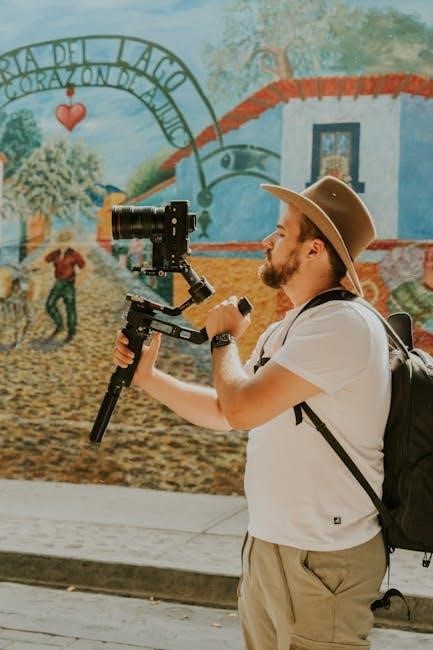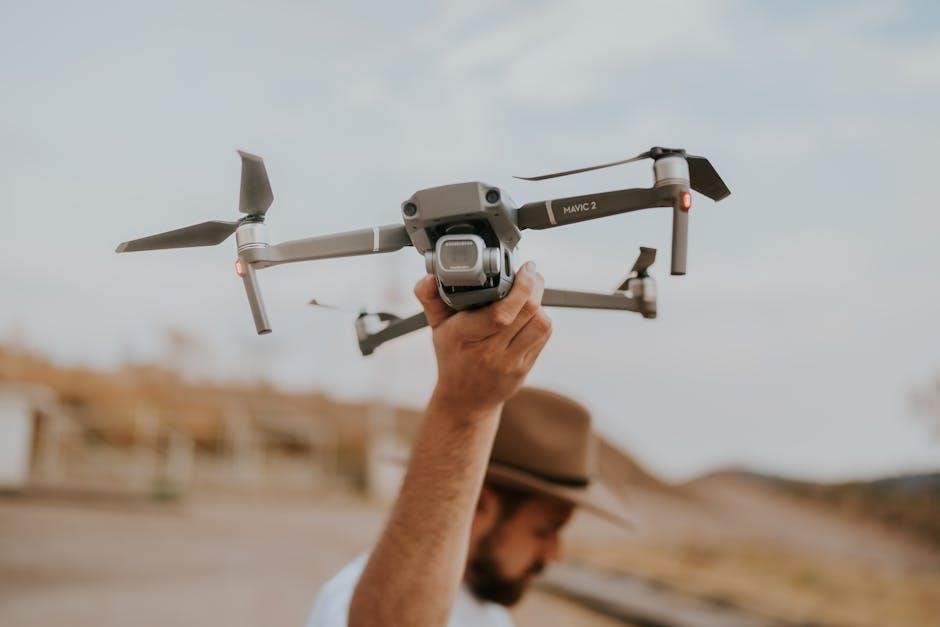Cop cameras are essential tools in modern law enforcement, enhancing accountability and providing vital evidence in interactions between officers and the public. They promote transparency, improve trust, and ensure adherence to legal standards, making them indispensable for maintaining justice and safety.
1.1 Overview of Cop Cameras and Their Importance
Cop cameras, or body-worn cameras, are small, visible devices worn by law enforcement officers to record interactions with the public. They play a crucial role in promoting accountability and transparency, ensuring that both officers and citizens are held to high standards. These cameras capture high-quality video and audio evidence, which is invaluable for investigations, court proceedings, and training purposes. By providing an unbiased record of events, they help build trust between law enforcement and the communities they serve, fostering safer and more equitable interactions. Their importance lies in their ability to protect both officers and the public while maintaining accountability.
1.2 Brief History and Evolution of Body-Worn Cameras
Body-worn cameras have evolved significantly since their introduction in the 1990s. Early models, like the VIEVU LE3, were bulky and had limited functionality. Advances in technology led to smaller, more efficient devices. The 2010s saw widespread adoption, with brands like Axon (formerly Taser) pioneering integrated systems. Recent models now feature HD video, night vision, and cloud storage. This evolution reflects growing demand for accountability and transparency in law enforcement, making body cameras indispensable tools for modern policing. Their development continues to improve evidence collection and public trust.

Popular Models of Cop Cameras
Popular models include the Zetronix BlueLine, PatrolEye-Ultra-1296P, and Axon Body 3, known for their durability, HD recording, and advanced features like night vision and extended battery life.
2.1 Zetronix BlueLine Police Body Camera
The Zetronix BlueLine Police Body Camera is a high-performance device designed for law enforcement. It features IR sensitivity adjustment for low-light recording and HD video capture. The camera is durable, with a long-lasting battery, making it ideal for extended shifts. Its user-friendly interface allows easy operation, and it comes with built-in memory for storing evidence. The BlueLine is known for its reliability and is widely used by officers to ensure accountability and transparency in their interactions with the public.
2.2 PatrolEye-Ultra-1296P Police Body Camera
The PatrolEye-Ultra-1296P is a cutting-edge body camera tailored for law enforcement. It offers 1296p resolution, ensuring crisp video quality, and features a quick activation mode. With 32GB built-in memory, it stores ample evidence securely. The camera is lightweight and water-resistant, designed for comfort during long duties. Its intuitive controls enable seamless operation, making it a preferred choice for officers needing reliable, high-quality recording capabilities in diverse field conditions.
2.3 Axon Body 3 Camera
The Axon Body 3 Camera is a high-performance device designed for law enforcement, offering advanced features like 1080p HD video recording and enhanced low-light performance. It includes articulation for flexible viewing angles and seamless integration with Evidence.com for efficient evidence management. The camera is durable, built to withstand tough environments, and features advanced audio clarity. Its intuitive interface ensures officers can focus on their duties while reliably capturing critical incidents, making it a trusted tool for modern policing needs.

System Requirements and Compatibility
Cop cameras require compatible operating systems, sufficient RAM, and storage for optimal performance. Ensure hardware meets specified standards and integrates seamlessly with law enforcement management software systems.
3.1 Minimum System Requirements for Body Camera Software
For optimal performance, body camera software requires a 64-bit operating system (Windows 10+, macOS 10.15+, or Linux), an Intel Core i5 or equivalent processor, and at least 4GB RAM. Ensure 10GB of free storage for installations and updates. A USB 3.0 port is necessary for camera connectivity. Internet access is needed for software updates and cloud integration. Compatibility with law enforcement management systems is crucial for seamless evidence management. Adhering to these specs ensures smooth operation and data integrity.
3.2 Compatibility with Law Enforcement Management Systems
Body camera software must integrate seamlessly with law enforcement management systems (LEMS) to ensure efficient evidence sharing and case management. Compatibility with platforms like Axon Evidence, Evidence.com, or police RMS is crucial. Many cameras support direct uploads to these systems, streamlining workflows; Additionally, integration with police dashboards and other digital tools enhances operational efficiency. Manufacturers often provide compatibility lists, ensuring alignment with agency-specific systems. Proper integration ensures data security, access control, and adherence to departmental protocols, making it a critical factor in system selection and deployment.

Installation and Setup

Connect the camera to your PC via USB, install the provided driver software, and follow on-screen instructions to complete the setup. Ensure proper mounting for optimal functionality.
4.1 Software Installation Steps
To install the software for your cop camera, connect the device to your PC using the provided USB cable. Double-click the setup file, typically labeled “auto driver installation,” found on the CD or downloaded from the manufacturer’s website. Follow the on-screen instructions to select your preferred language and choose the installation location; Once installed, restart your computer to ensure all drivers are properly configured. For additional guidance, refer to the user manual or online support resources provided by the manufacturer. Proper installation ensures optimal camera functionality and performance.
4.2 Physical Mounting and Placement of the Camera
Mount the camera securely on your uniform or equipment using the provided clips or adhesive mounts. Ensure the camera is positioned to capture an unobstructed view of interactions. For optimal recording, place it on the chest or shoulder, aligning the lens to face outward. Avoid obstructing the view with badges or gear. Test the camera’s angle and adjust as needed to ensure clarity. Proper placement is crucial for capturing accurate and reliable evidence. Refer to the user manual for specific mounting recommendations tailored to your camera model.
Operating the Camera
Operating the camera involves pressing the power button to start recording. LED indicators show status. Use basic controls for video and audio capture. Proper placement ensures clear evidence effectively.
5.1 Basic Controls and Functions
The basic controls of a cop camera include a power button to start/stop recording, LED indicators for status, and a microphone for audio capture.
Pressing the power button once typically begins recording, while pressing it again stops it.
LED lights often flash to indicate active recording, ensuring officers and subjects are aware.
The camera also features a emergency recording button for critical situations.
Proper placement on the uniform ensures clear video and audio capture, while playback functions allow reviewing footage immediately.
These controls are designed for intuitive operation, minimizing distractions during interactions.
5.2 Advanced Features and Customization
Advanced features of cop cameras include infrared sensitivity adjustment for low-light recording and customizable video quality settings.
Users can enable pre-recording to capture events before activation.
Some models offer customizable police IDs and device IDs for easy identification.
Advanced time-stamping and GPS tagging provide precise metadata.
Customizable motion detection and automatic IR activation enhance evidence capture.
These features ensure high-quality evidence collection and adaptability to various operational needs, making the cameras versatile tools for law enforcement.
Recording Settings and Evidence Management
Cop cameras offer adjustable video quality and format options, ensuring high-resolution evidence capture.
They provide secure storage solutions and organized management of recorded incidents for legal purposes.
6.1 Video Quality and Format Options
Cop cameras offer high-resolution video recording, typically in 1080p or 1296p, ensuring clear evidence capture.
They support various formats like MP4 and AVI for compatibility.
Adjustable settings include aspect ratios (e.g., 16:9) and frame rates for optimal video quality.
Some models feature infrared sensitivity for enhanced low-light recording.
These options ensure videos are crisp and detailed, critical for law enforcement evidence and accountability purposes.
6.2 Managing and Storing Recorded Evidence
Cop cameras store recordings securely, often using internal memory or external storage solutions.
Evidence management systems ensure recordings are encrypted and protected from tampering.
Access is restricted to authorized personnel, maintaining chain of custody.
Some systems offer cloud-based storage for scalability and remote access.
Proper labeling and categorization are essential for efficient retrieval;
Secure deletion protocols prevent unauthorized access or misuse of sensitive data.
Safety Instructions
Use cop cameras in well-ventilated areas to prevent overheating. Avoid exposing devices to water or extreme temperatures. Handle with care to prevent damage and ensure secure fastening.
7.1 Precautions for Using Body Cameras
When using body cameras, avoid exposing them to water or extreme temperatures. Ensure the device is securely fastened to prevent detachment during duty. Handle the camera with care to avoid physical damage. Store it in a dry, cool place when not in use. Always follow the manufacturer’s guidelines for charging and maintenance. Regularly check for software updates to ensure optimal performance. Keep the camera away from direct sunlight for extended periods to prevent overheating. Adhere to these precautions to extend the camera’s lifespan and maintain reliability.
7.2 Handling and Maintenance Tips
Regularly clean the camera lens with a soft cloth to maintain video clarity. Avoid using harsh chemicals or abrasive materials that may damage the surface. Update the firmware periodically to ensure all features function properly. Store the camera in a protective case when not in use to prevent scratches or impacts. Check the battery health and replace it as recommended by the manufacturer. Ensure all cables and connectors are securely attached to avoid data loss or connectivity issues.

Troubleshooting Common Issues
Check USB connections for proper installation and restart the camera to resolve connectivity problems. Ensure video and audio settings are correctly configured for smooth recording.
8.1 Resolving Connectivity Problems
To address connectivity issues with your cop camera, first ensure the USB cable is securely connected to both the camera and the computer. If using a docking station, verify proper alignment and contact. Restart the camera and check for driver updates, as outdated software can cause connection failures. Install drivers from the provided CD or download them from the manufacturer’s website. For wireless models, reset the camera and reconnect to the network. Ensure Bluetooth or Wi-Fi settings are enabled and properly configured. Consult the user manual for specific troubleshooting steps tailored to your model.
8.2 Fixing Video and Audio Recording Issues
If your cop camera experiences video or audio issues, begin by checking the microphone for blockages or damage. Ensure the camera’s lens is clean and free from obstructions. Restart the device to reset the recording function. Verify that the memory card is properly inserted and has sufficient storage space. For audio problems, disable and re-enable the microphone in settings. Review the camera’s firmware and update if necessary. If issues persist, refer to the user manual or contact technical support for further assistance or potential hardware repairs.
Cop cameras have become indispensable tools in modern law enforcement, ensuring transparency, accountability, and improved public trust. By providing high-quality evidence and enhancing officer conduct, these devices play a vital role in maintaining justice and safety. Proper setup, maintenance, and adherence to guidelines are essential for maximizing their effectiveness. As technology evolves, body cameras will continue to be a cornerstone in policing, fostering a safer and more just society for all. Their impact is undeniable, making them a critical component of law enforcement operations worldwide.